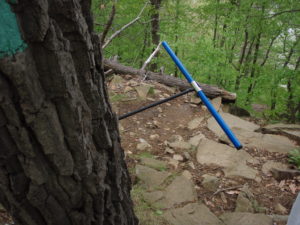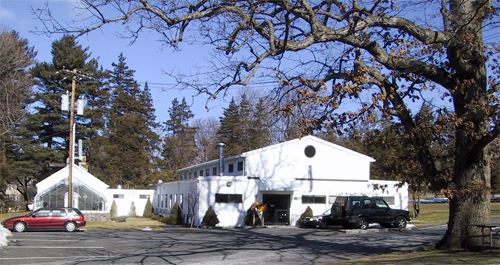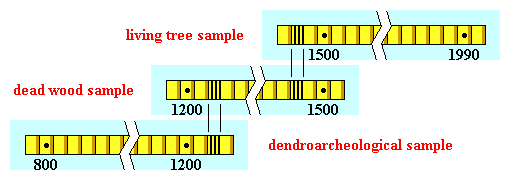“More than How Old? Understanding Climate Changes from Tree Rings”
with Mukund Palat Rao, Daniel Bishop, and Rose Oelkers
Originally presented 8 Apr 2017



In this E2C Workshop, you will be able to learn about cutting-edge research and techniques used by dendrochronologists from Mukund Palat Rao, Daniel Bishop, and Rose Oeklers. Each of these TRL scientists will share their experiences and insights gained from field and lab studies.
Tree rings are a valuable proxy used for understanding past climate, ecological change, and extreme events. Beyond providing the age of a tree, tree rings provide annual, and sometimes seasonal, estimates of climatic variables such as drought, rainfall, and temperature. At shorter time scales, tree rings can detect extreme ice storms, insect defoliations, and even volcanic activity. During our Earth2Class Workshop, we will introduce participants to fundamental methods in tree-ring science (dendrochronology), including sample collection, visual dating, and incorporating tree-ring data to answer important scientific questions. We will also discuss a range of topics in which scientists in the LDEO Tree Ring Lab have been engaged: (1) Tree rings and implications for carbon in the northeastern US, (2) volcanic activity and tree rings, and (3) analyzing tree-ring density via image analysis across the Northern Hemisphere.
(1) Forests are a significant carbon sink, moderating a major greenhouse gas in Earth’s atmosphere, atmospheric CO2. Variability and long-term trends in growth rates are captured by tree rings, allowing us to evaluate past and future changes in carbon sequestration, the storage of carbon in tree’s woody tissue. Declining growth rates and sudden responses to extreme events can have large-scale impacts on this natural carbon sink. We will investigate recent sugar maple growth declines and red oak responses to severe insect defoliation outbreaks in the northeastern US, discussing the causes and short- and long-term impacts of reductions in growth in eastern forests.
(2) Large volcanic eruptions represent an important source of natural climate variability and abrupt change in Earth’s climate system. Large eruptions inject sulfur dioxide into the stratosphere where it is converted into aerosolized sulfuric acid. These aerosols can persist in the stratosphere for several years, both reflecting and absorbing incoming solar radiation. Such large eruptions typically cause rapid global cooling of surface temperatures. Volcanic eruptions are therefore useful events to study the response of Earth’s climate system to short-term changes in Earth’s energy balance. In this talk, I will first discuss some of the temperature effects of volcanic forcing and follow that with relatively recent work by our group focusing on hydroclimate effects of volcanism.
(3) Latewood density has proven to be an essential parameter in assessing the inter-annual variability of tree rings. In addition to the traditional ring-width proxy, maximum latewood density (MXD) is commonly found to record a strong climate signal for summer temperatures in the Northern Hemisphere. In particular, MXD data is valuable for reconstructing past temperatures when the initial ring-width relationship is weak or unstable. However, measuring MXD is both expensive and time-consuming. Through the development of image analysis programs such as Coorecorder, a new proxy Blue Light Intensity (BI) has emerged as a similar parameter to latewood density measurements. This cheaper, user-friendly, method has been used as a powerful teaching tool to help students new to dendrochronology visualize tree growth. Here, we will compare BI tree-ring chronologies generated from different species in very distinct environments and discuss the success of creating deeper connections with students to science using interactive platforms.

Tree-Ring Lab (TRL) scientists are dedicated to expanding the use and application of tree-ring research around the world to improve our understanding of past climate and environmental history. Current research concentrates on the use of tree-ring data networks to study regional climate, global climate teleconnections and anthropogenic impacts on forest growth. Exploring new species in new regions, building collaborations around the world, and developing new quantitative techniques, TRL researchers are committed to advancing dendrochronology and paleoclimatology, as well as the ethic of good science.
Rose Oelkers 
Rose is currently serving her second year as a full-time lab technician at Lamont. Currently she is involved in several exciting projects including stable isotopes, wood density, ecophysiology, and ring-width analysis of tree-rings. She is interested in all aspects of Earth Sciences, is determined to gain the knowledge and experience to grow and excel in her field, and is willing to work to her full potential to effectively raise awareness of the sensitive relationship among people, climate, and the environment.
Mukund Rao 
Mukund is in his third year as a PhD student at Lamont-Doherty Earth Observatory, Columbia University. Prior to starting his PhD he pursed an M.A. in Climate and Society at Columbia University and a B.Tech in Chemical Engineering at Amrita School of Engineering, India. His research interests include the interactions between ecosystems and climate. Today’s presentation describes some of his research into the impact volcanoes can have on climate and tree growth.
Daniel Bishop 
Daniel is in his first year as a PhD student at Lamont in the Department of Earth and Environmental Sciences. Previously, he worked as a lab technician at both Lamont and Harvard Forest working on a variety of tree-ring projects. Prior to his technician work, he completed his M.S. in Ecology and Ecosystems at SUNY College of Environmental Science and Forestry and his B.S. in Atmospheric Science at Cornell University. His research interests broadly include bioclimatology and climate dynamics, specifically investigating the topics of drought, carbon sequestration in forest ecosystems, and land-atmosphere feedbacks.
View an introduction to Dendrochronology: Learning from Tree Rings (2017)
Links to previous E2C Workshops featuring TRL Scientists

[Source: http://www.ltrr.arizona.edu/skeletonplot/exampleapplication.htm]
Classroom Resources
CLASSROOM ACTIVITIES AND OTHER RESOURCES
Selected tree-ring activities for the classroom:
“TRL Station Activities” (led by Rose, Mukund, and Dan)
“Nicole Davi’s “Gulf of Alaska Dendrochronology” Activity”
“Notes for the Lamont Open House Forest Walk“
“Learning from Tree Rings” by Diana Helene Frank (E2C participant)
“The Ultimate Tree-Ring Web Pages“
“Dendrochronology for Educators“
“NOVA: Building a Tree-Ring Timeline”
“NOVA Methusalah Tree activity”
“Tree-Ring Record of Wetland Changes”
Related interesting story involving LDEO dendrochronology research can be found at
“Climate and Conquest: How Did Genghis Khan Rise?”

Other Resources for This Topic
Roman rise and fall ‘recorded in trees’
By Mark Kinver Science and environment reporter, BBC News


